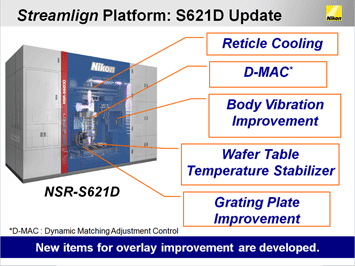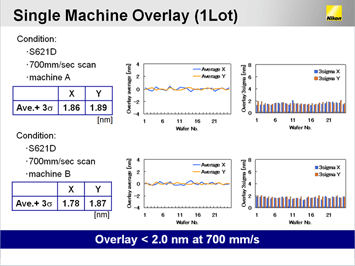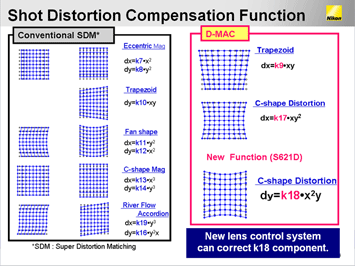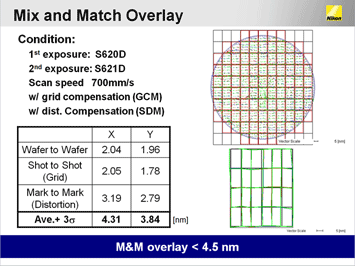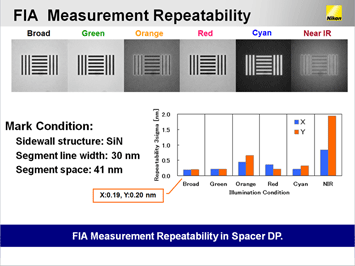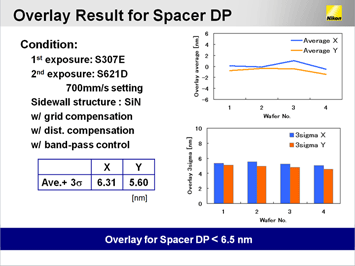Enabling ArF Extension with Overlay Enhancement Solutions
At SPIE Advanced Lithography, Yuji Shiba, Nikon System Designer, reported that ArF extension utilizing double patterning (DP) is driving increased defect densities—and enhanced overlay performance will be crucial to ensure this is successful. He explained that the NSR-S621D is the latest evolution of the proven Streamlign platform and features a number of innovations that heighten alignment and matching capabilities to enable industry-leading overlay accuracy and stability in manufacturing.
Shiba began by reminding the audience how repeated exposures can induce problematic reticle expansion and explained that in order to mitigate this issue, a newly developed Reticle Cooling System nozzle was mounted under the S621D illumination unit to cool the reticle with clean dry air (CDA) during exposure. He also described how the S621D incorporates a new grating plate structure that minimizes linearity variation across the wafer stage area to markedly improve stability, thereby reducing the frequency of grating plate calibrations and boosting productivity.
In addition, Shiba reported that the S621D incorporates a sophisticated Wafer Table Temperature Control System that uses a feedback loop to optimize temperature stability during exposure to further enhance overlay performance and stability. These innovations enable single machine overlay performance of mean+3σ < 2.0 nm across the lot. Shiba also commented that in high volume manufacturing, lot-to-lot overlay stability is essential, and reported that S621D single machine overlay (SMO) error less than 2.5 nm was maintained across five lots.
Figure 1. The NSR-S621D is the latest evolution of the proven Streamlign platform and features a number of innovations that heighten alignment and overlay matching capabilities (left image). These innovations enable SMO mean+3σ < 2.0 nm across the lot.
Shiba then discussed mix-and-match overlay. For heightened matching accuracy, compensation functions that adjust the grid and distortion of one scanner to another are needed. He explained that while compensation for 3rd, 5th and random grid mapping errors as well as shot distortion compensation based on the wafer grid has been available for some time, Nikon is introducing newly developed shot distortion compensation capabilities provided by Dynamic Matching Adjustment Control (D-MAC). While D-MAC previously supported correction for k9 trapezoid shape and k17 c-shape distortions across the scan slit, Shiba announced that k18 c-shape distortion compensation was recently added, enabling the scanner to also correct for this distortion along the scan direction. He explained that D-MAC functions by moving some of the lens elements up or down and tilting them during exposure in order to modify the projected shot image.
With mix-and-match overlay, intra-lot variation must be minimized. Shiba showed that the combination of Reticle Cooling and D-MAC successfully mitigate distortion variation, even under high dose conditions. He then shared actual mix-and-match overlay performance achieved using the S620D immersion scanner for the 1st print and the S621D scanner for the 2nd print. After common linear terms were removed and grid as well as shot distortion compensation was performed, the total overlay error across the entire lot was better than 4.5 nm (mean+3σ).
Figure 2. D-MAC functions by moving some of the lens elements up or down and tilting them during exposure in order to modify the projected shot image (left image). Total overlay error across the entire lot was better than 4.5 nm (mean+3σ).
Having already discussed single machine overlay and mix-and-match overlay, Shiba moved then to discuss product overlay performance. He reminded the audience that while single machine overlay is impacted by the tool’s grid stability and accuracy, the grid and distortion differences between machines must also be controlled for mix-and-match overlay. He cautioned that for product overlay, process-specific alignment issues must be considered as well. He stated that the S621D uses the well-established Five Eye FIA system, and then explained how this system optimizes wafer alignment across three steps. First, the illumination color and sigma is automatically selected for the best mark viewing, then the alignment shot map is optimized to eliminate damaged marks based on variation in their signal shapes and measurement results. In the final step, the signal processing algorithm is optimized using a band-pass control filter. Shiba described this process wherein a 1D alignment signal is obtained using FIA; this signal is then derived into its constituent orders that can then be individually selected to give the most robust alignment signal for calculation.
Shiba proceeded to describe an alignment mark evaluation using spacer double patterning. He reported that in this situation, signal contrast is very low and signal profile is unstable due to the sidewall shape, making alignment mark measurement challenging. The Nikon FIA system measured this mark with extreme accuracy, automatically determining the appropriate illumination color condition for this situation, based on FIA repeatability analysis.
Figure 3. FIA measured the mark with extreme accuracy and automatically determined the appropriate illumination color condition for this situation (left image). Total overlay for a spacer DP process that utilized the S307E and the S621D was below 6.5 nm.
Shiba later showed initial overlay performance achieved using spacer DP. He noted that although the 1st pass on this evaluation actually used an early generation ArF dry S307E system with the NSR-S621D 2nd print, total overlay was still better than 6.5 nm. Shiba highlighted that given the dramatic enhancements of the S621D, the results would have been far better if it was used for the 1st layer as well.
Concluding his detailed presentation, Shiba announced that the NSR-S621D has demonstrated single machine overlay across the lot below 2.0 nm as well as mix-and-match overlay accuracy < 4.5 nm. He reminded the audience that on-product overlay requires optimization for process-specific conditions in order to achieve manufacturing requirements. He summarized that the S621D D-MAC, Reticle Cooling, Grid and Distortion Matching, and wafer alignment functions enable excellent on-product overlay performance to satisfy the requirements of 22 nm and beyond using ArF extension.
